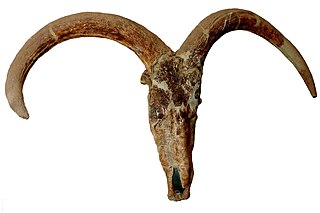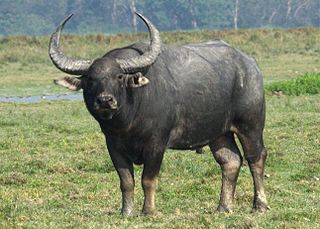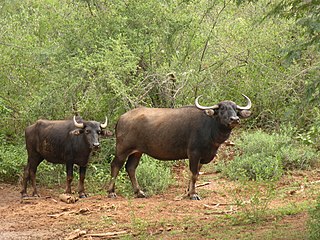
Anoa, also known as dwarf buffalo and sapiutan, are two species of the genus Bubalus, placed within the subgenus Anoa and endemic to the island of Sulawesi in Indonesia: the mountain anoa and the lowland anoa. Both live in undisturbed rainforest and are similar in appearance to miniature water buffaloes, weighing 150–300 kg (330–660 lb).

The water buffalo, also called the domestic water buffalo or Asian water buffalo, is a large bovid originating in the Indian subcontinent and Southeast Asia. Today, it is also found in Italy, the Balkans, Australia, North America, South America and some African countries. Two extant types of water buffalo are recognized, based on morphological and behavioural criteria: the river buffalo of the Indian subcontinent and further west to the Balkans, Egypt and Italy and the swamp buffalo, found from Assam in the west through Southeast Asia to the Yangtze valley of China in the east.

Bubalus is a genus of Asiatic bovines that was proposed by Charles Hamilton Smith in 1827. Bubalus and Syncerus form the subtribe Bubalina, the true buffaloes.

The reticulated python is a python species native to South and Southeast Asia. It is the world's longest snake, and the third heaviest after the green anaconda and Burmese python. It is listed as least concern on the IUCN Red List because of its wide distribution. In several countries in its range, it is hunted for its skin, for use in traditional medicine, and for sale as pets. Due to this, reticulated pythons are one of the most economically important reptiles worldwide.

Carabao is the Philippine English term for the water buffalo. In the Philippines, Carabao represents hard work.

The tamaraw or Mindoro dwarf buffalo is a small buffalo belonging to the family Bovidae. It is endemic to the island of Mindoro in the Philippines, and is the only endemic Philippine bovine. It is believed, however, to have once also thrived on the larger island of Luzon. The tamaraw was originally found all over Mindoro, from sea level up to the mountains, but because of human habitation, hunting, and logging, it is now restricted to only a few remote grassy plains and is now a critically endangered species.

Physeteroidea is a superfamily that includes three extant species of whales: the sperm whale, in the genus Physeter, and the pygmy sperm whale and dwarf sperm whale, in the genus Kogia. In the past, these genera have sometimes been united in a single family, the Physeteridae, with the two Kogia species in the subfamily Kogiinae; however, recent practice is to allocate the genus Kogia to its own family, the Kogiidae, leaving the Physeteridae as a monotypic family, although additional fossil representatives of both families are known.

The pygmy right whale is a species of baleen whale. It may be a member of the cetotheres, a family of baleen whales which until 2012 were thought to be extinct; C. marginata has otherwise been considered the sole member of the family Neobalaenidae and is the only member of the genus Caperea. First described by John Edward Gray in 1846, it is the smallest of the baleen whales, ranging between 6 and 6.5 metres in length and 3,000 and 3,500 kilograms in mass. Despite its name, the pygmy right whale may have more in common with the gray whale and rorquals than the bowhead and right whales.

The saltwater crocodile is a crocodilian native to saltwater habitats, brackish wetlands and freshwater rivers from India's east coast across Southeast Asia and the Sundaic region to northern Australia and Micronesia. It has been listed as Least Concern on the IUCN Red List since 1996. It was hunted for its skin throughout its range up to the 1970s, and is threatened by illegal killing and habitat loss. It is regarded as dangerous to humans.

Stegodon is an extinct genus of proboscidean, related to elephants. It was originally assigned to the family Elephantidae along with modern elephants but is now placed in the extinct family Stegodontidae. Like elephants, Stegodon had teeth with plate-like lophs that are different from those of more primitive proboscideans like gomphotheres and mammutids. The oldest fossils of the genus are found in Late Miocene strata in Asia, likely originating from the more archaic Stegolophodon, shortly afterwards migrating into Africa. While the genus became extinct in Africa during the Pliocene, Stegodon remained widespread in South, Southeast and East Asia until the end of the Pleistocene.

Dwarf elephants are prehistoric members of the order Proboscidea which, through the process of allopatric speciation on islands, evolved much smaller body sizes in comparison with their immediate ancestors. Dwarf elephants are an example of insular dwarfism, the phenomenon whereby large terrestrial vertebrates that colonize islands evolve dwarf forms, a phenomenon attributed to adaptation to resource-poor environments and lack of predation and competition. Some modern populations of Asian elephants have also undergone size reduction on islands to a lesser degree, resulting in populations of pygmy elephants.

Pelorovis is an extinct genus of African wild cattle which existed during the Pleistocene epoch. The best known species is Pelorovis oldowayensis from Olduvai Gorge in Tanzania, from the Early Pleistocene. The species "Pelorovis" antiquus from the Late Pleistocene-Holocene has since been moved into Syncerus, the same genus as living African buffalo.

The wild water buffalo, also called Asian buffalo, Asiatic buffalo and wild buffalo, is a large bovine native to the Indian subcontinent and Southeast Asia. It has been listed as Endangered in the IUCN Red List since 1986, as the remaining population totals less than 4,000. A population decline of at least 50% over the last three generations is projected to continue. The global population has been estimated at 3,400 individuals, of which 3,100 (91%) live in India, mostly in Assam. The wild water buffalo is the most likely ancestor of the domestic water buffalo.

The tribe Bovini, or wild cattle, are medium to massive bovines that are native to Eurasia, North America, and Africa. These include the enigmatic, antelope-like saola, the African and Asiatic buffalos, and a clade that consists of bison and the wild cattle of the genus Bos. Not only are they the largest members of the subfamily Bovinae, they are the largest species of their family Bovidae. The largest species is the gaur, weighing up to 1,500 kg (3,300 lb).

The largest prehistoric animals include both vertebrate and invertebrate species. Many of them are described below, along with their typical range of size. Many species mentioned might not actually be the largest representative of their clade due to the incompleteness of the fossil record and many of the sizes given are merely estimates since no complete specimen have been found. Their body mass, especially, is largely conjecture because soft tissue was rarely fossilized. Generally the size of extinct species was subject to energetic and biomechanical constraints.

Syncerus antiquus is an extinct species of buffalo from the Late Pleistocene and Holocene of Africa. It was one of the largest species in its family, potentially weighing up to 2,000 kilograms (4,400 lb). Due to this fact, it is sometimes known as the African giant buffalo. The time of its extinction is of debate; Syncerus antiquus either became extinct at the end of the Late Pleistocene about 12,000 years ago or during the Holocene, some 4,000 years ago.

The mountain anoa(Bubalus quarlesi) also known as Quarle's anoa, is a species of buffalo endemic to Sulawesi. Its closest relative is the lowland anoa, and it is still a debate as to whether the two are the same species or not. It is also related to the water buffalo, and both are classified in the genus Bubalus.

The lowland anoa(Bubalus depressicornis) is a species of buffalo endemic to Sulawesi. Its closest relative is the mountain anoa, and it is still a debate as to whether the two are the same species or not. It is also related to the water buffalo, and both are classified in the genus Bubalus.

Bubalina is a subtribe of wild cattle that includes the various species of true buffalo. Species include the African buffalo, the anoas, and the wild water buffalo. Buffaloes can be found naturally in sub-Saharan Africa, South Asia and Southeast Asia, and domestic and feral populations have been introduced to Europe, the Americas, and Australia. In addition to the living species, bubalinans have an extensive fossil record where remains have been found in much of Afro-Eurasia.


















